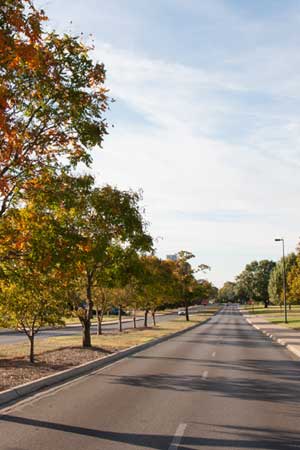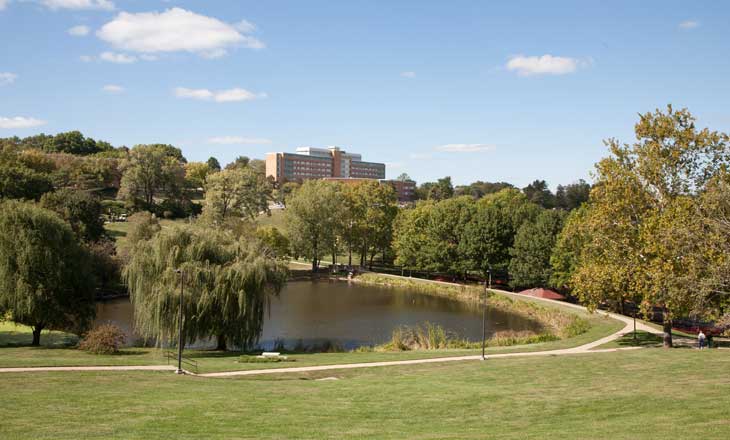| 2013 Fall | story by DEREK HELMS | photos by STEVEN HERTZOG |

The University of Kansas Center for Sustainability was established in 2007. The center is a direct result of work by students, staff and campus administrators with a common interest in a sustainable future for the university. The Center for Sustainability promotes a culture of sustainability at KU in order to protect natural ecosystems, create economic prosperity and treat all people with equality and respect. The Center works across campus to support sustainable practices in operations, education, research and campus life.
Jeff Severin, director of the center, says the work done by his staff has two goals, both of which are green.
“We want to help the university use energy and resources as efficiently as possible,” he explains. “That means consuming less, which is beneficial both environmentally and fiscally.
In 2004, the university established the Sustainability Task Force to research the feasibility of developing a Center for Sustainability to serve as a hub for research and projects that address environmental issues and work to make campus operations more environmentally sustainable. The task force identified reasonable need for the center and, in the Spring of 2006, the center was funded through Tuition Enhancement.
Severin served on the Sustainability Task Force and has directed the center since it’s inception. He says the work done by the center has experienced a natural evolution.
 “When we opened the center most of our work was done on boards and committees,” the soft-spoken Severin explains. “As time passed and we were able to education individuals and committees about specific steps that can be taken to increase efficiency and sustainability. Many times our suggestions were met with resistance, because change is often not welcomed. But now our conversations are more operational. We aren’t making as many suggestions, we are helping people implement the changes they have already decided to make.”
“When we opened the center most of our work was done on boards and committees,” the soft-spoken Severin explains. “As time passed and we were able to education individuals and committees about specific steps that can be taken to increase efficiency and sustainability. Many times our suggestions were met with resistance, because change is often not welcomed. But now our conversations are more operational. We aren’t making as many suggestions, we are helping people implement the changes they have already decided to make.”
Severin says the center’s most important work to date was publishing Building Sustainable Traditions, the first comprehensive sustainability plan for the Lawrence campus, in October of 2011. The 67-page document outlines a framework to build new traditions based on the tenets of sustainability.
“Publishing the sustainability report was a really solid step for us,” Severin says. “It’s a document that can help in all aspects of campus sustainability and serve as a reference point for the entire university.”
Building Sustainable Traditions identified 9 key areas of university life that can be addressed and modified to increase efficiency:
• Administration, Development and Planning
• Curriculum and Research
• Student Life
• Energy
• Built Environment
• Campus Grounds
• Procurement
• Waste
• Transportation
The center functions, in essences, as an environmental advisor to all university departments. Severin and his staff has worked hard to change many small habits of office life that, when multiplied by the thousands of university employees, can result in significant waste of energy and resources.
 “We help people and offices make some minor changes that can have a large cumulative affect,” Severin says. “For instance, if we can have each floor of an office or building use one central printer, instead of individual desktop printers, can make a very, very big difference. The energy is more concentrated, so we consume less energy and electric bills will be reduced. And, as anyone who works in office supplies know, printer components like ink and toner can be very expensive. Larger printers are less expensive to maintain.”
“We help people and offices make some minor changes that can have a large cumulative affect,” Severin says. “For instance, if we can have each floor of an office or building use one central printer, instead of individual desktop printers, can make a very, very big difference. The energy is more concentrated, so we consume less energy and electric bills will be reduced. And, as anyone who works in office supplies know, printer components like ink and toner can be very expensive. Larger printers are less expensive to maintain.”
Since the center opened in 2006, Severin says the university has made major changes to increase sustainability. From light bulbs to more efficient electronics, small changes are being made that, in the long run will result in significant financial savings.
“One of the most frustrating aspects of sustainability is that real, concrete, big-picture changes can’t be measured for another 50 to 100 years,” Severin says. “But we are implementing practices here that will show tangible results in 5 to 10 years.”
Severin says his office can’t put a dollar amount on financial savings to the university since the center opened, but he has seen a significant change in the role of the center.
 “I use to go to meetings about new construction and remodeling and things like that and be very vocal about what steps the department needed to take to increase the sustainability of the plan,” he says. “In the past few years, that has almost totally changed. Now, instead of making sure we see plans and then offering our input, we are called and get to answer qu estions. The idea of sustainable practices isn’t something we are fighting to get implanted in campus planning. It has become an accepted aspect of the university life. It’s so great to be able to go to a meeting and sit quietly because the department has already factored in our recommendations.”
“I use to go to meetings about new construction and remodeling and things like that and be very vocal about what steps the department needed to take to increase the sustainability of the plan,” he says. “In the past few years, that has almost totally changed. Now, instead of making sure we see plans and then offering our input, we are called and get to answer qu estions. The idea of sustainable practices isn’t something we are fighting to get implanted in campus planning. It has become an accepted aspect of the university life. It’s so great to be able to go to a meeting and sit quietly because the department has already factored in our recommendations.”
Perhaps the most substantial, and tangible, example of the Center for Sustainability’s contribution to the university is the reconstruction of parking lot 54 on the Southwest corner of Naismith & 15th Street. The lot had deteriorated badly and had significant functionality issues. The university decided to make it the first “green” parking lot on campus.
The majority of construction was funded by KU Parking & Transit department with the City of Lawrence contributing funding which covered the cost of replacing old sanitary sewer lines under the parking lot. The Kansas Department of Health and Environment (KDHE) provided a $450,000 loan with principle forgiveness (essentially a grant with a small amount of interest payment).
The KDHE money came with conditions, according to Paul Graves, Deputy Director at KU Design Construction Management.
KDHE required prior approval of the construction documents; inclusion of standard forms and language in the bid package (such as nondiscrimination certification and disadvantaged business entity good faith efforts); an annual 2.29% interest rate on the principle from the first disbursement until substantial completion – this will likely be about one month’s interest totaling around $1,000; and an operating & maintenance plan to address long-term care of the pervious pavement and rain garden.
Funding has also been made available through KU’s Revolving Green Loan Fund. In 2010, KU established a revolving green loan fund to finance energy conservation projects. The fund allows investment in smaller conservation projects, with the resulting savings returned to the fund for future reinvestment. In short, the savings from these projects will finance perpetual implementation of projects with energy savings.
“Construction is on schedule for substantial completion by the end of September,” Graves says. “The lot will be open for parking by October, although there will still be some remaining work including landscaping and signs. The fact that this project includes underground storage of storm water runoff added substantial work for excavation and rerouting sanitary sewer; and the pervious concrete pavement required special training for the contractor and workers at the mix plant.”
With major construction completed, crews will begin landscaping the lot in early October.

“Planting has to wait until sustained cooler weather,” Graves explains. “Numerous shade trees will be planted in the islands and some ground cover will be planted at a few locations, most notably in the rain garden near the lot entrance. Student volunteers will be recruited to help plant the rain garden. The landscaping will help remove pollution from storm water runoff and will draw water out of the underground storage system to replenish its storage capacity. In addition, all the greenery will make the lot more pleasant for those who use it.”
Given KU’s sustainability goals, the KDHE grant purpose, and the highly visible location, KU plans to make Lot 54 a showcase sustainability demonstration project. In addition to the enhanced storm water management, the lot was constructed with longer-life concrete instead of asphalt; the concrete will have a high albedo (light coloration) to reduce heat island effects; numerous shade trees will be planted to reduce the heat island effect (as well as treating storm water runoff); KU Facilities Services will process removed timber for firewood at the Chamney kiln and wood chips for landscaping use; and asphalt millings,
The lot is being reconfigured to increase the number of parking spaces and improve accessibility. A major change involves replacing sparsely landscaped parking islands oriented north-south with more densely landscaped islands oriented east-west; this reorientation of the parking islands is necessary to accommodate the subsurface storm water storage system and to improve accessibility with flatter pavement slopes in the east-west direction – and using stored storm water runoff, it will also provide subsurface irrigation for the trees to be planted in the islands.
 Graves says the lot is a major step forward for the university.“This is a major sustainable project for KU and the parking lot’s prominent location on campus will showcase it to the community,” Graves says. “The lot is located across the street from the engineering quad and researchers will have ongoing opportunities to monitor conditions in the underground storage via special ports installed for that purpose, along with regular infiltration tests to check the performance of the pervious pavement, and the ability to evaluate the vegetation too.”
Graves says the lot is a major step forward for the university.“This is a major sustainable project for KU and the parking lot’s prominent location on campus will showcase it to the community,” Graves says. “The lot is located across the street from the engineering quad and researchers will have ongoing opportunities to monitor conditions in the underground storage via special ports installed for that purpose, along with regular infiltration tests to check the performance of the pervious pavement, and the ability to evaluate the vegetation too.”
Severin hope the high visibility of lot 54 will help encourage more sustainable building.
“Lot 54 is a highly visible example of what can be done to create a more sustainable campus,” Severin says. “It demonstrates the new culture of sustainability showing up in the way we make decisions. The collaborative effort and quality result is a great showpiece for what we can do to help the university consume less and be as efficient as possible with necessary consumption.” ■
